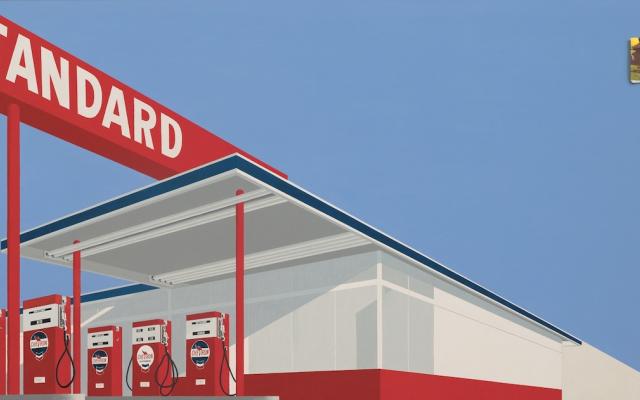Janus
2013 - Film & Video (Film & Video)
3:30 min.
Miljohn Ruperto
Miljohn Ruperto’s high-definition video Janus takes its name from the two-faced Roman god of duality and transitions, of beginnings and endings, gates and doorways. He is usually depicted with two faces as he looks both forward and backward, to the future and the past. The video, which is deftly animated in collaboration with Aimée de Jongh, presents a close-up of a dying “duck-rabbit,” a vivified version of an ambiguous illustration made popular by the Austrian-British philosopher Ludwig Wittgenstein in his Philosophical Investigations . One’s attention shifts between seeing a duck and a rabbit, prompted by the animal’s movements and sounds. Its red eyes, wounded body, and belabored breathing suggest the end of life. Just as it appears to take its last breath, however, it inhales again, teetering on the precipice. As the video continues its unceasing loop, a resolution is withheld. In this way, Ruperto makes a connection between the ambiguity of visual perception and the paradox of life and death as embodied by this fragile animal in its final moments.
Miljohn Ruperto is a cross-disciplinary artist working across photography, cinema, performance, and digital animation. His work refers to historical and anecdotal occurrences, and speculates on the nature of assumed facts and the construction of truth. Often involving replicas, modified versions, and enactments—including Chinese-made reproductions of Caspar David Friedrich’s The Monk by the Sea ; modified images based on the 15th century Voynich Manuscript; or reworked footage of Filipino actress Isabel Rosario Cooper—Ruperto takes cultural and historical references and untethers them from their original context to challenge our perception and generate something altogether new. Ruperto’s work is often informed by his collaborations with experts from other disciplines including Dutch animator Aimée de Jongh, neuroscientist and engineer Rajan Bhattacharyya, photographer Ulrik Heltoft among others. Through a richness and diversity of lenses, and preferencing the obscure, mysterious and the magical, his work challenges fixed conceptions of truth and history, and instead speaks of an indeterminacy and subjectivity of experience that renders truth and fiction near indistinguishable.
Colors:
Related works featuring themes of: » Black-and-White Photography, » Contemporary Fact Versus Fiction, » Dark, » Flora, » Filipino and Danish

© » KADIST
Natasha Wheat
2011Natasha Wheat’s Kerosene Triptych (2011) is composed of three images, one each from the digital files of the Library of Congress, the Smithsonian Institution, and the Field Museum tropical research archive...

© » KADIST
Tina Modotti
1927Modotti’s Diego Rivera Mural: Billionaires Club; Ministry of Education, Mexico D...

© » KADIST
Agnieszka Kurant
2018Agnieszka Kurant’s Placebo VIII brings together a series of imaginary pharmaceuticals invented within the fictional narratives of literature and film...

© » ART & OBJECT
Ed Ruscha
Ed Ruscha's Poetry of the American Experience | Art & Object Skip to main content Subscribe to our free e-letter! Webform Your Email Address Role Art Collector/Enthusiast Artist Art World Professional Academic Country USA Afghanistan Albania Algeria American Samoa Andorra Angola Anguilla Antarctica Antigua & Barbuda Argentina Armenia Aruba Ascension Island Australia Austria Azerbaijan Bahamas Bahrain Bangladesh Barbados Belarus Belgium Belize Benin Bermuda Bhutan Bolivia Bosnia & Herzegovina Botswana Bouvet Island Brazil British Indian Ocean Territory British Virgin Islands Brunei Bulgaria Burkina Faso Burundi Cambodia Cameroon Canada Canary Islands Cape Verde Caribbean Netherlands Cayman Islands Central African Republic Ceuta & Melilla Chad Chile China Christmas Island Clipperton Island Cocos (Keeling) Islands Colombia Comoros Congo - Brazzaville Congo - Kinshasa Cook Islands Costa Rica Croatia Cuba Curaçao Cyprus Czechia Côte d’Ivoire Denmark Diego Garcia Djibouti Dominica Dominican Republic Ecuador Egypt El Salvador Equatorial Guinea Eritrea Estonia Eswatini Ethiopia Falkland Islands Faroe Islands Fiji Finland France French Guiana French Polynesia French Southern Territories Gabon Gambia Georgia Germany Ghana Gibraltar Greece Greenland Grenada Guadeloupe Guam Guatemala Guernsey Guinea Guinea-Bissau Guyana Haiti Heard & McDonald Islands Honduras Hong Kong SAR China Hungary Iceland India Indonesia Iran Iraq Ireland Isle of Man Israel Italy Jamaica Japan Jersey Jordan Kazakhstan Kenya Kiribati Kosovo Kuwait Kyrgyzstan Laos Latvia Lebanon Lesotho Liberia Libya Liechtenstein Lithuania Luxembourg Macao SAR China Madagascar Malawi Malaysia Maldives Mali Malta Marshall Islands Martinique Mauritania Mauritius Mayotte Mexico Micronesia Moldova Monaco Mongolia Montenegro Montserrat Morocco Mozambique Myanmar (Burma) Namibia Nauru Nepal Netherlands Netherlands Antilles New Caledonia New Zealand Nicaragua Niger Nigeria Niue Norfolk Island Northern Mariana Islands North Korea North Macedonia Norway Oman Outlying Oceania Pakistan Palau Palestinian Territories Panama Papua New Guinea Paraguay Peru Philippines Pitcairn Islands Poland Portugal Puerto Rico Qatar Romania Russia Rwanda Réunion Samoa San Marino Saudi Arabia Senegal Serbia Seychelles Sierra Leone Singapore Sint Maarten Slovakia Slovenia Solomon Islands Somalia South Africa South Georgia & South Sandwich Islands South Korea South Sudan Spain Sri Lanka St...

© » KADIST
Ari Marcopoulos
1998A photograph of a tin box full of marijuana simply titled Green Box, speaks to the constantly changing status of the substance–once taboo or illicit, now a symbol of a growing industry in Northern California...

© » KADIST
Elad Lassry
2012The black-and-white photograph Men (055, 065) (2012) depicts two similarly built young men – young and slim, with dark tousled hair and a square jaw line – seated aside one another in identical outfits...

© » KADIST
Daniel Crooks
2014The Illusion of Everything (2014) follows an unseen pedestrian as he navigates the Australian city of Melbourne’s dense and intricate network of laneways...

© » LARRY'S LIST
Ed Ruscha
The fashion designer is selling off all the art inside his West Village townhouse at Sotheby’s New York to make way for a new collection....

© » APERTURE
An-My LE
For the past two decades, An-My Lê has used photography to examine her personal history and the legacies of US military power, probing the tension between experience and storytelling....

© » KADIST
An-My LE
2010The print Patient Admission, US Naval Hospital Ship Mercy, Vietnam (2010) features an Asian Buddhist monk and an American Navy Solider on board the Mercy ship –one of the two dedicated hospital ships of the United States Navy– sitting upright in their chairs and adopting the same posture...

© » KADIST
Wong Hoy Cheong
2009Days of Our Lives: Reading is from a series of work was created for the 10th Biennale de Lyon by the artist...

© » KADIST
Enrique Ramirez
2019Enrique Ramirez’s La Memoria Verde is a work of poetry, politics, and memory created in response to the curatorial statement for the 13th Havana Biennial in 2019, The Construction of the Possible ...

© » KADIST
Allan Sekula
1973San Pedro is a seaside city, part of the Los Angeles Harbor, sitting on the edge of a channel...

© » KADIST
Elad Lassry
2013In his composition, Chocolate Bars, Eggs, Milk, Lassry’s subjects are mirrored in their surroundings (both figuratively, through the chocolate colored backdrop and the brown frame; and literally, in the milky white, polished surface of the table), as the artist plays with color, shape, and the conventions of representational art both within and outside of the photographic tradition...

© » KADIST
Wong Hoy Cheong
2004Re: Looking marks a new phase in Wong’s work which connects his region’s history with other parts of the world...

© » KADIST
Agnieszka Kurant
2022For Sentimentite Agnieszka Kurant collaborated with Justin Lane, CEO and Co-Founder of CulturePulse, to gather global sentiment data that has been harvested from millions of Twitter and Reddit posts related to 100 seismic events in recent history...




